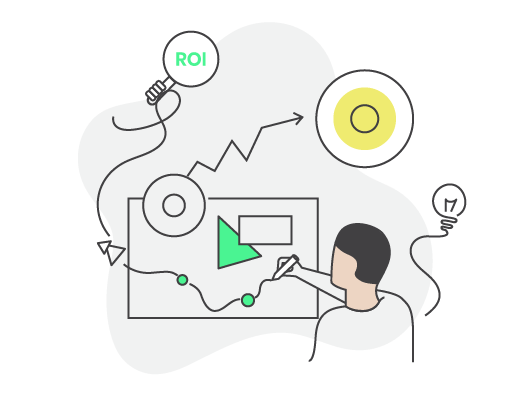
The world is moving fast into becoming a hyper-connected, digital world. Like it or not, organizations- large or small- have to embrace digital transformation.
Digital Transformation is Key to Good Business.
But, are you doing it right?
For the last two decades, technology has been the driver of efficiency, reducing business costs and increasing revenues. Today’s technological advancements are promising potential of innovation and disruption for businesses. Most of the businesses end up investing at least 90-95% of time and budget in technology-driven aspects of their digital transformation strategy. Whereas they invest a mere 5-10% of their time and budget in designing for customer experiences.
But, are we missing a key link here? The key ingredient of product/ service success is customer and user experience of products. In fact, the end customer interacts through experiences created, and hardly knows about the technology built under it. The 5-10% efforts in experience is 100% of what the customers see and experience.
5-10% invested in experience design = 100% for customers
It is crucial to understand, the customer views a mere 5% of your efforts of the entire transformation and makes the decision that seals the fate of your business.

Design as a business differentiator.
The missing link
There are a number of influential factors to be considered when setting out on the transformation journey. These include aspects such as the changing customer expectations, cultural transformations, a decline in differentiation among competitors – to name just a few. Technology-driven value of convenience is no longer a differentiator.
Ergo, the customer-centric approach is the link to business success. And the intent of the technology advancements should be aligned with the customer-centric strategy. Inculcating the user-centric approach can garner plenty of benefits.
It is very important to identify and understand the challenges that may be stopping the business from penetrating the markets as leaders. The user-centric business strategy will trigger true differentiation in the industry.
Here are some of the components vital for implementing user-centric design as the business differentiation strategy:
1. Re-focus.
User-centric approach with Serious UX
Businesses need to understand their customers. They need to understand and gain a wide-lens view of the needs and requirements of the customers that they are catering to. The bottom line is – if you cater to customers’ needs and expectations, you’ll be in the business.
With serious UX, one starts by asking the right questions about customer goals, and business goals. By asking questions such as – What is it that the customer is trying to accomplish? What is it that the business is offering to them? Why should customers choose you above other competitive brands in the market? Serious UX marries customer goals with business goals.
2. Research.
Know your strength and value
Applying the same user-centric approach, one can perform thorough research of the market position of the business. The overall perception of the business in the minds of customers is important.
In a highly competitive market, it is difficult for a customer to differentiate between the unique aspects of the businesses from each other. Drawing forth the core values, strengths, and unique offerings of the business through research is important. This data will help the business define the strategies that will be aligned with the rightly identified customer goals.
These data-driven insights will not only reflect in business strategies but will also inform the experience designed for customers.
3. Revive.
Differentiate your services
It is also necessary to understand that, if we are offering services and designing for real people, then humanizing the experience should be the singular approach. Especially in the current economy.

Customers value experiences more.
It is not just about the product and its interactions with the customers. But it is more to do with the entire experience that is crafted for the customers. The business needs to seek out ways to add value to customers’ lives. That is the only way, the business will be relevant to the customer and thus ahead in the competition.
These three components will assist the businesses in utilizing Design as a business differentiator.
An ideal UX design partner
Understanding how UX Design is the business differentiator alone is not sufficient. But, making the right choice of a design partner becomes more crucial. Businesses need to be wary of UX service provider agencies, that claim to deliver UX Design, but treat as an afterthought. Businesses require a design partner that has the potential to work towards holistic design solutions that businesses require to forge a future that best serves their end-users.
These design partners will not just deliver solutions with the right methodologies but also take risks with the business. These specialized UX design partners will and can work in different engagement models with the client. Businesses take the decision of hiring these partners based on a number of factors such as – control of UX- timelines, quality, cost, and management overheads.
All in all, an ideal UX design partner would be a company that would go much beyond the visual WOW. A company who’s design contribution has effectively facilitated channeling of the product or service objectives. And that may have resulted in business conversions on a much larger scale.
For companies on the digital transformation journey, UX design is an important factor to be considered. Whether your business is articulating the strategy or has the strategy in place and is in the stage of implementing it, UX design is power for your business. And taking all the right design decisions even more crucial.
Amplify your brand presence with the best UX design studio that truly aligns your needs with those of your consumers! Get in touch with us at YUJ Designs, today!






